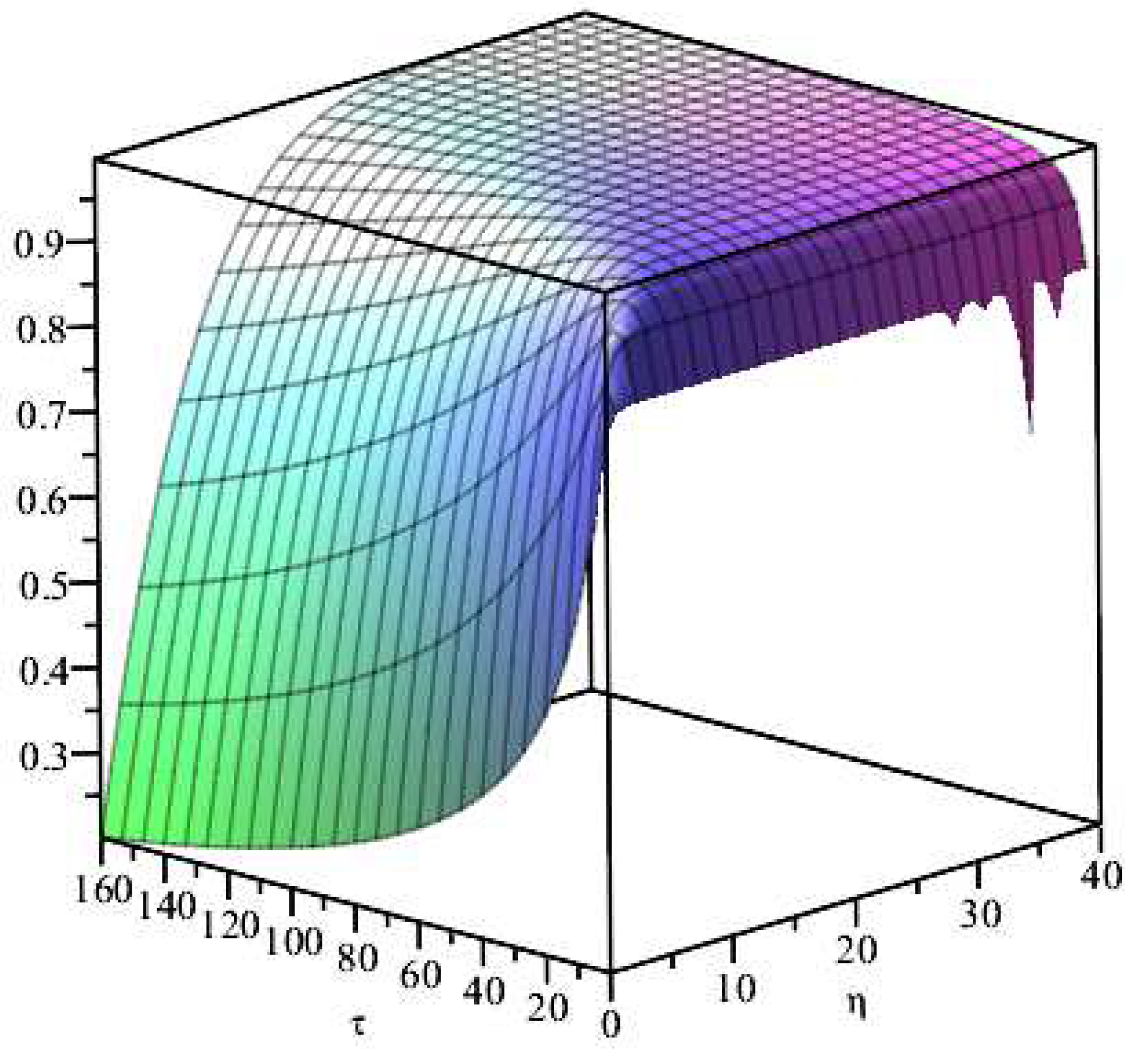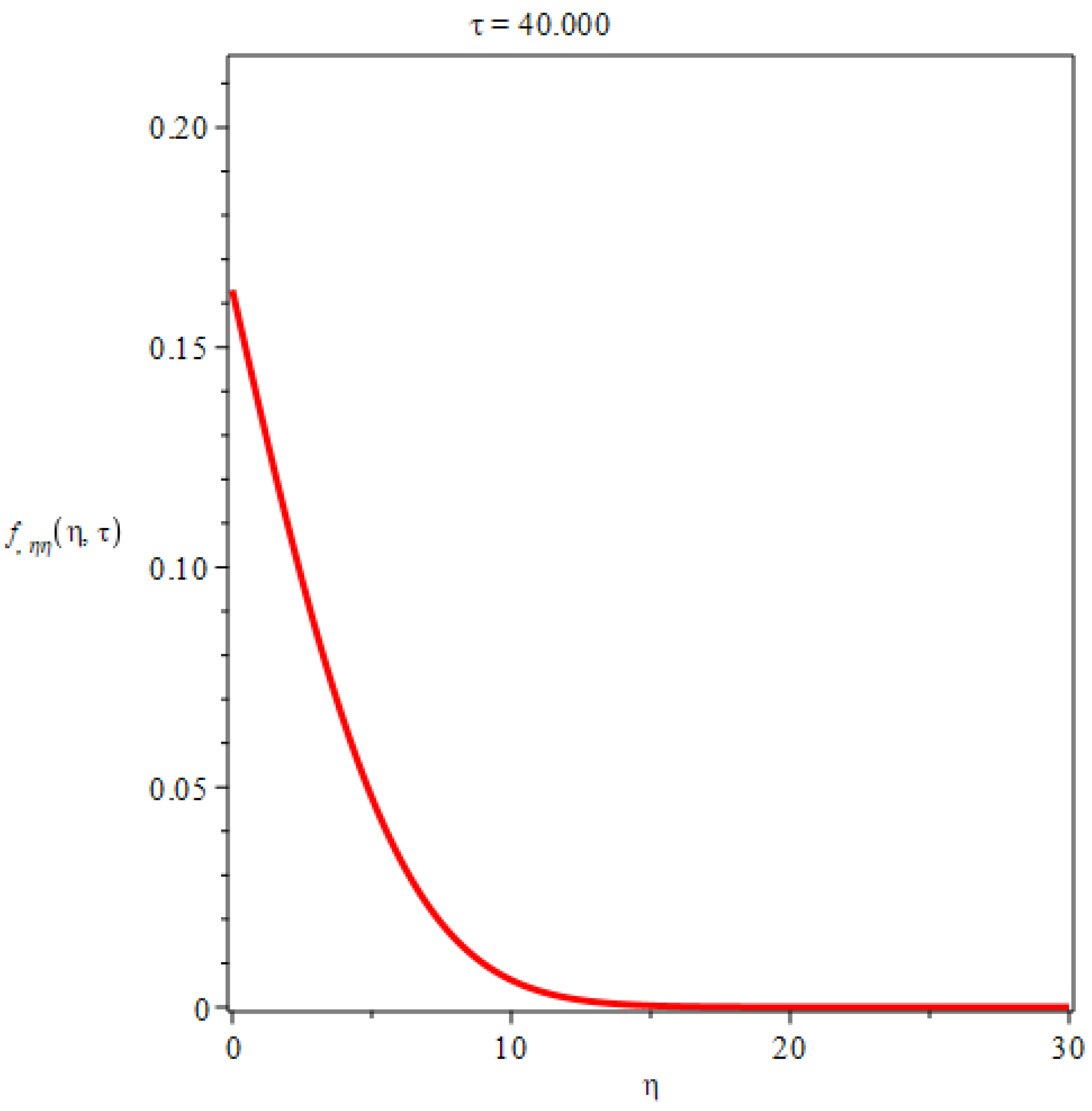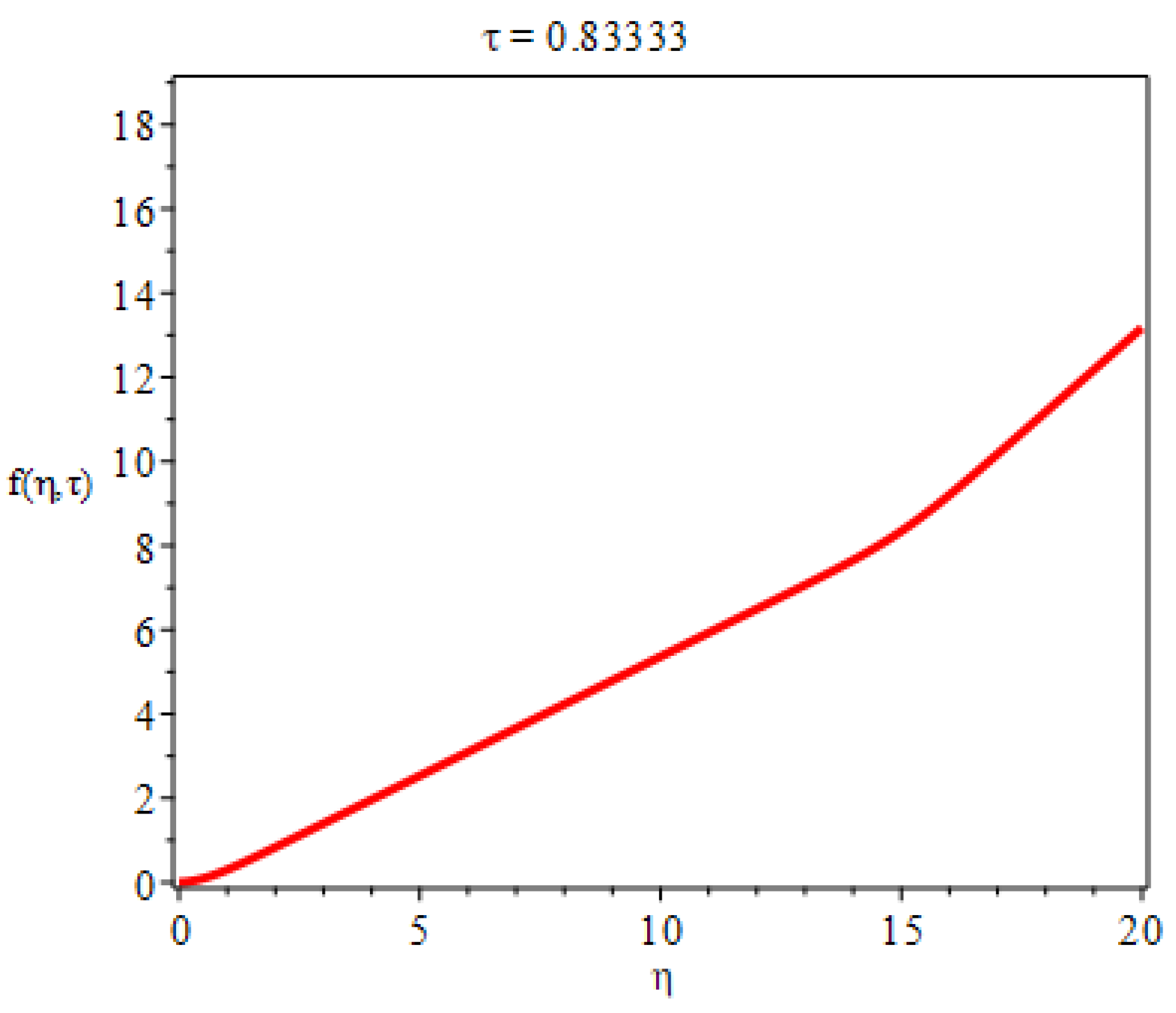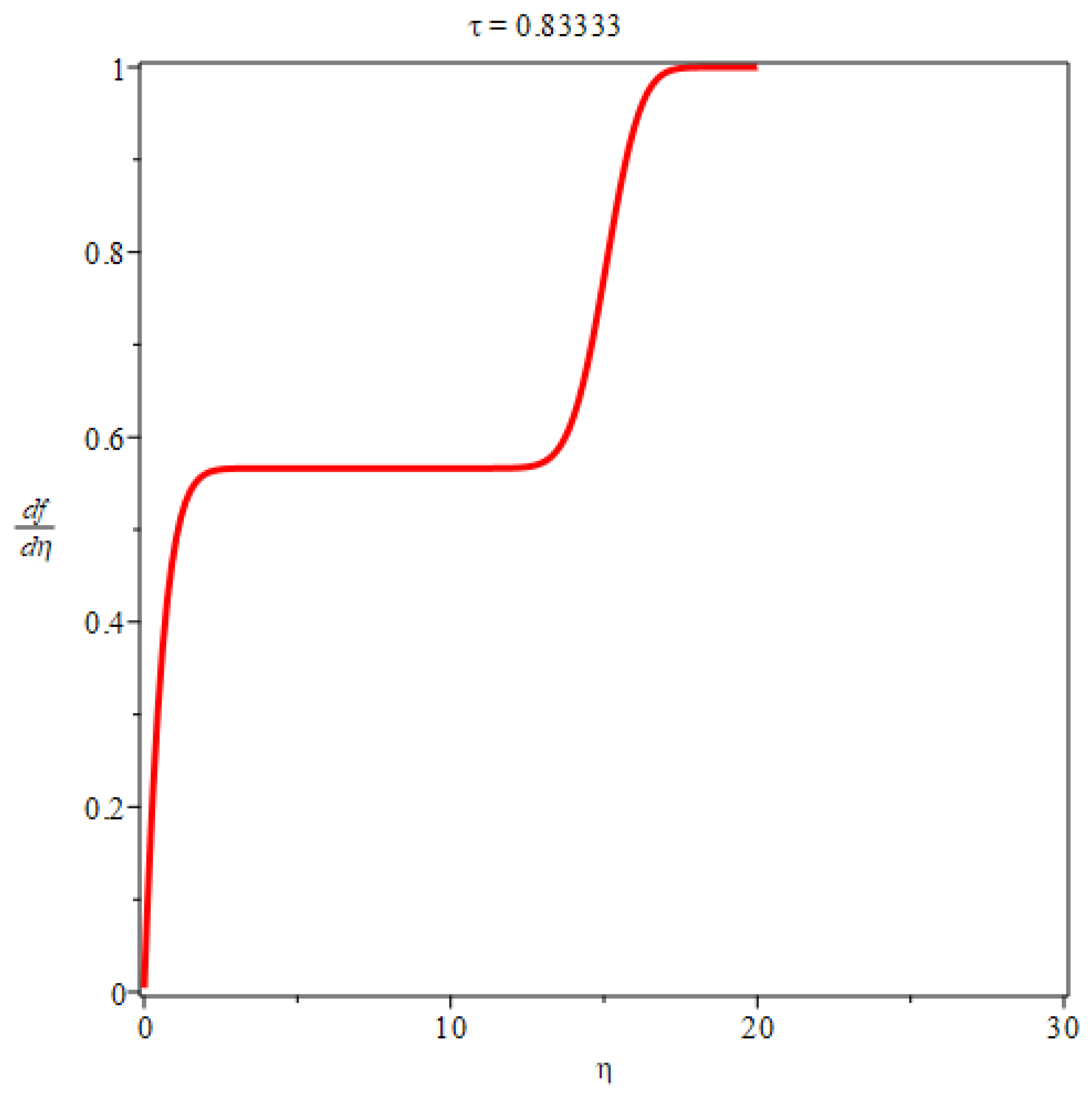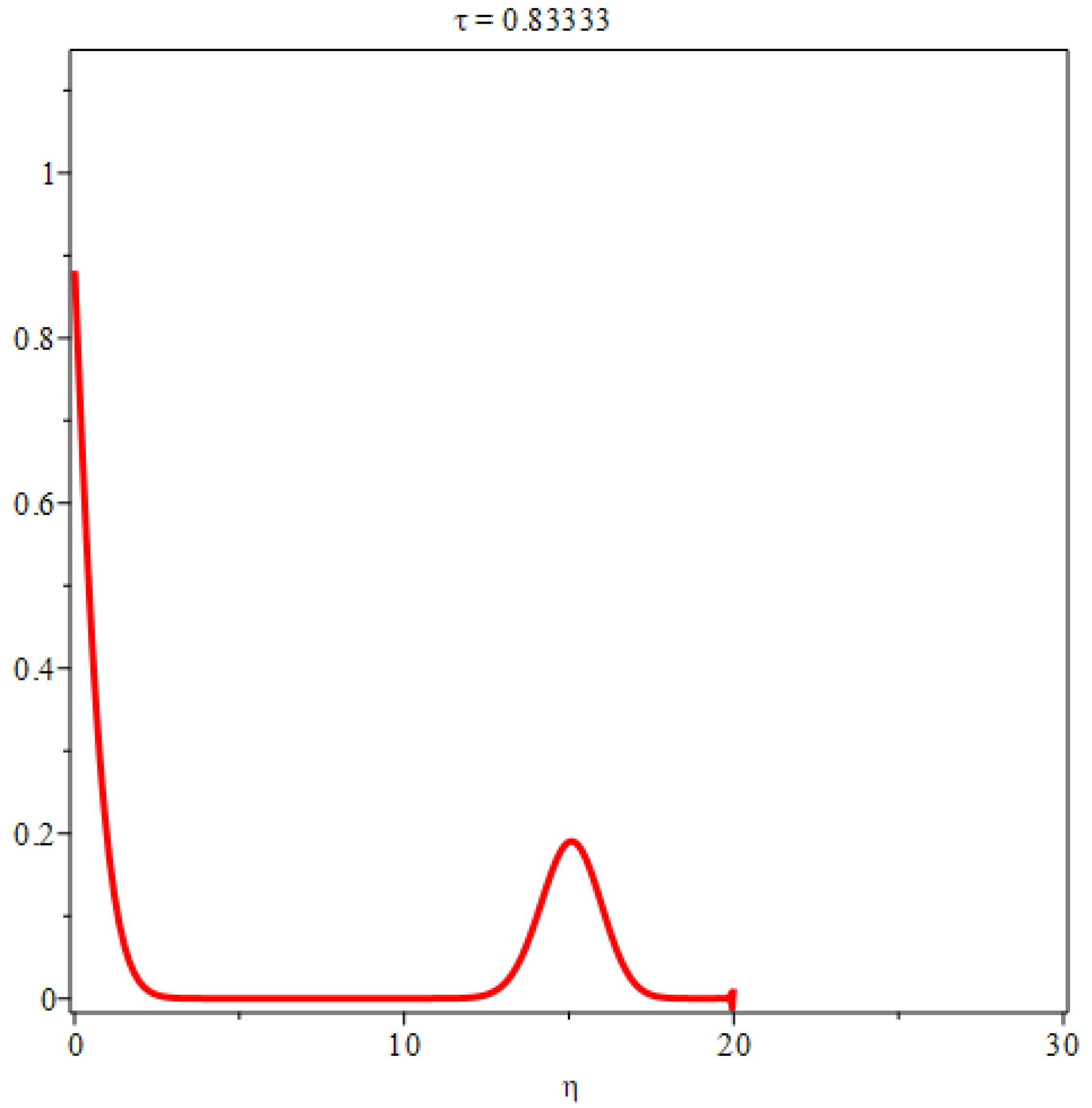1. Introduction
The origins of turbulence are a widespread phenomenon and remain one of the most significant unsolved mysteries in classical physics [
1,
2,
3,
4,
5,
6,
7,
8,
9,
10,
11,
12,
13,
14,
15,
16,
17,
18,
19,
20,
21,
22,
23]. The study of unsteady flows is considered crucial for understanding the dynamics of laminar-turbulence transition, especially in cases involving accelerated flows, motions from rest, or transitions from one steady flow to another [
12,
16].
The Navier-Stokes equations, which govern fluid flow, are highly complex and pose significant challenges in obtaining exact solutions. Only a few one-dimensional non-steady problems have been able to achieve exact solutions, such as Stokes’ problem and the flow due to an oscillating infinite plane. The latter was the first exact solution in fluid dynamics.
One example of an exact solution is Rayleigh’s problem, which involves an infinite flat plate impulsively started into motion in its own plane with a velocity of U. The solution to this problem is given by the equation , where erfc is the complementary error function.
However, despite these achievements, no exact solutions have been obtained for the unsteady boundary layer equations of any two-dimensional problem. This lack of exact solutions has shattered our expectations of finding them based on historical exact solutions. As a result, we are left with no choice but to confront this challenge and strive to find new ideas and approaches to explore new frontiers in understanding unsteady flows.
After introduction in
Section 1, the rest of this paper is organized as follows. In
Section 2, we formulate the 2D turbulent boundary layers and introduce a similarity transformation. Under special conditions, the partial differential equations of the 2D turbulent boundary layers can be reduced to a single ordinary differential equation. In
Section 3, Flow along a flat plate at zero incidence in a uniform stream is studied, whos exact solution is obtained for the first time. In
Section 4, the convergent channel flows is investigated. In
Section 5, the wedge flows is also studied. Finally, in
Section 6, conclusions and perspectives are drawn.
2. Similarity transformations of 2D laminar boundary layers equations
A thin flat plate is immersed at zero incidence in a uniform stream, which flows with speed and is assumed not to be affected by the presence of the plate, except in the boundary layer. The fluid is supposed unlimited in extent, and the origin of coordinates is taken at the leading edge, with x measured downstream along the plate and y perpendicular to it.
The unsteady Navier-Stokes equations of the two dimensional boundary layers flow under gradient,
, are reduced to
and initial-boundary conditions:
where
is the kinematic viscosity,
is flow density,
p is pressure,
is outer of boundary layer potential flow velocity. The pressure gradient must be negative, namely
, to maintain the flow motion. For a curved boundary layers, the coordinates
should be replaced by
, where
s is arc length and
n is normal to the curve layers.
Integration of Equation (2) yields
, where
is a function of
x only [
3], then
. From Bernoulli equation, we have relation:
, leads to
. The boundary equations are reduced to following:
Introducing a stream function
and express the velocity components as follows
with the relation in Equation (
8), the mass conservation Equation (refrans-4) is satisfied, and the momentum conservation Equation (7) becomes
and corresponding boundary conditions.
A suitable scaling factor for u could be the free stream velocity , while for y, "boundary-layer thickness" , which increases with distance x, could be used. The similarity law of the velocity profile can thus be written as with , where the function is independent of x.
Regarding the similarity of time
t, it is known that the time for any bulk property of the fluid, such as vorticity or momentum, to diffuse through a distance
is of the order of
(the "diffusion time") [
6], hence, we can introduce a dimensionless time as
.
Based on the above understanding, introducing following transformations
where the dimensionless time transformation in Equation (12) is the key of success to solve the 2D unsteady laminar boundary layer flows and is introduced firstly in this Letter.
To formulate the Equation (
9) in terms of
, we need to calculate some derivatives of function
respect to both
x and
y, for simplification, we denote
and
and so on. Noting the
and
, and by chain rule of differential, we can get
Thus the velocity components become
Substituting Equations (13)–(18) into Equation (
9), we have a single partial differential equation as follows
where the coefficients are
,
, and
, and initial-boundary conditions become:
and
.
If the coefficient
,
and
were constants, the Equation (
21) is solvable because it will get rid of the variable
x. Following from the relation
, its integration leads to
, canceling out
by
, we have
, hence when
, the general solution of this equation is of the form:
where the exponent
.
In the same way, we have , leads to a relation , namely . It implies that is constant if both and were constants.
Regarding the solution of Equation (
21), for constants
and
, Equation (
21) can be numerically solved.
3. Flow along a flat plate at zero incidence in a uniform stream
In the case of two dimensional plate boundary layers, if then we have , flow velocity . can be any real number, without loss of generality, we set , hence . The boundary thickness is .
The stream function is of the form
where
, and diffusion time
.
The equation Equation (
21) can be reduced to the following:
With the help of Maple and initial-boundary conditions, we can find the similarity solution of Equation (
25) as follows
where the integral constants
and notations
in which,
and
are the Kummer function [
24].
After applying initial-boundary conditions, we have
From the solution in Equation (
28), we can get some useful derivatives as follows
and
and
where
is the Gamma function [
24].
By differentiation, the flow velocity components are obtained as
The shear stress is given by
The wall shear stress
, we have
4. The Main-Stream Convergent Channel Flow
In this case, the parameters and , we have the convergent channel flow velocity function , which simply expresses the coacervation of the discharge in the flow, being the angle between the planes. Now we have the boundary layer thickness , similarity variable , and dimensionless diffusion time .
The Equation (
21) can be reduced to the following:
5. The mAin-Stream Wedge Flow
In this case wedge flows, the parameters , here we set , thus we have and , hence the wedge flows velocity function , the boundary layer thickness , similarity variable , and dimensionless diffusion time .
The equation Equation (
21) can be reduced to the following:
6. Conclusions and Perspectives
The transformation of the 2D unsteady laminar boundary layer equations into a single partial differential equation with constant coefficients is a clever approach that allows for the exact solution of the velocity field.
Overall, this theoretical studies contributes to the understanding the origins of turbulence from unsteady laminar boundary flows investigation.
Data Availability Statement
The data supporting the findings of this study are available from the corresponding author upon reasonable request.
Acknowledgments
This work was supported by Xi’an University of Architecture and Technology (Grant No. 002/2040221134). The author would like to express his gratitude to Prof. Cunbiao Lee from Peking University for engaging and informative discussions. Special thanks are also extended to Academician Xiaogang DENG of the Chinese Academy of Sciences for identifying an error in the differential calculation of .
Conflicts of Interest
The author declares that he has no known competing financial interests or personal relationships that could have appeared to influence the work reported in this paper.
References
- Schlichting, H. Boundary Layer Theory, McGraw-Hills, 1960 translated by J. Kestin.
- Morkovin, M.V. On the many faces of transition, in Viscous Drag Reduction, edited by C. S. Wells (Springer, New York, 1969), pp. 1-C31Morkovin, M.V. On the many faces of transition, in Viscous Drag Reduction, edited by C. S. Wells (Springer, New York, 1969), pp. 1-C31.
- Tennekes, H.; Lumley, J.L. A First Course of Turbulence, The MIT Press, Cambridge (1972).
- Reshotko, E. Boundary-layer stability and transition. Annu. Rev. Fluid Mech. 8, 311–C349 (1976). [CrossRef]
- Bayly, B.J.; Orszag, S.A.; Herbert, T. Instability mechanisms in shear-flow transition. Annu. Rev. Fluid Mech. 20, 359–C391 (1988). [CrossRef]
- Rosenhead, L. Laminar Boundary Layers, Dover Publications, Inc. New York (1988).
- Beckwith, I.E.; C.G.M., III. Aerothermodynamics and transition in high-speed wind tunnels at NASA Langley. Annu. Rev. Fluid Mech. 22, 419–C439 (1990). [CrossRef]
- Kachanov, Y.S. Physical mechanisms of laminar-boundary-layer transition. Annu. Rev. Fluid Mech. 26, 411–C482 (1994). [CrossRef]
- Frisch, U. Turbulence, Cambridge University Press, Cambridge (1995).
- Reed, H.L.; Saric, W.S.; Arnal, D. Linear stability theory applied to boundary layers. Annu. Rev. Fluid Mech. 28, 389–C428 (1996). [CrossRef]
- Herbert, T. Parabolized stability equation. Annu. Rev. Fluid Mech. 29, 245–C283 (1997). [CrossRef]
- Lee, C.B. Possible universal transitional scenario in a flat plate boundary layer: Measurement and visualization. Phys. Rev. E 62, 3659 (2000). [CrossRef]
- Saric, W.S.; Reed, H.L.; White, E.B. Stability and transition of threedimensional boundary layers. Annu. Rev. Fluid Mech. 35, 413–C440 (2003). [CrossRef]
- Durbin, P.; Wu, X. Transition beneath vortical disturbances. Annu. Rev. Fluid Mech. 39, 107–C128 (2007). [CrossRef]
- Eckhardt, B.; Schneider, T.M.; Hof, B.; Westerweel, J. Turbulence transition in pipe flow. Annu. Rev. Fluid Mech. 39, 447–C468 (2007). [CrossRef]
- Lee, C.B.; Wu, J.Z. Transition in wall-bounded flows. Appl. Mech. Rev. 61, 030802 (2008). [CrossRef]
- Fedorov, A. Transition and stability of high-speed boundary layers. Annu. Rev. Fluid Mech. 43, 79–C95 (2011). [CrossRef]
- Zhong, X.; Wang, X. Direct numerical simulation on the receptivity, instability, and transition of hypersonic boundary layers. Annu. Rev. Fluid Mech.44, 527–C561 (2012). [CrossRef]
- Jiménez, J. Coherent structures in wall-bounded turbulence. J. Fluid Mech. 842, 513–C531 (2018). [CrossRef]
- Wu, X. Nonlinear theories for shear flow instabilities: Physical insights and practical implications. Annu. Rev. Fluid Mech. 51, 451–C485 (2019). [CrossRef]
- Lee, C.B.; Jiang, X.Y. Flow structures in transitional and turbulent boundary layer. Phys. Fluids 31, 111301 (2019). [CrossRef]
- Jiang, X.Y.; Lee, C.B.; Chen, X.; Smith, C.R.; Linden, P.F. Structure evolution at early stage of boundary layer transition: simulation and experiment. J. Fluid Mech. (2020), vol. 890.
- Sun, B.H. Thirty years of turbulence study in China. Appl. Math. Mech. 40(2) (2019) 193-214. [CrossRef]
- Abramowitz, M.; Stegun, I.; (Eds). Handbook of Mathematical Functions. New York: Dover, 1972.
|
Disclaimer/Publisher’s Note: The statements, opinions and data contained in all publications are solely those of the individual author(s) and contributor(s) and not of MDPI and/or the editor(s). MDPI and/or the editor(s) disclaim responsibility for any injury to people or property resulting from any ideas, methods, instructions or products referred to in the content. |
© 2023 by the authors. Licensee MDPI, Basel, Switzerland. This article is an open access article distributed under the terms and conditions of the Creative Commons Attribution (CC BY) license (http://creativecommons.org/licenses/by/4.0/).



